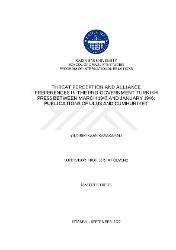| dc.contributor.advisor | Güvenç, Serhat | en_US |
| dc.contributor.author | Karakayalı, Yıldırım Kaan | |
| dc.date.accessioned | 2021-02-16T16:05:22Z | |
| dc.date.available | 2021-02-16T16:05:22Z | |
| dc.date.issued | 2020 | |
| dc.identifier.uri | https://hdl.handle.net/20.500.12469/3933 | |
| dc.description.abstract | Considered one of the most critical milestones in the history of Turkish Foreign Policy after the Second World War, the termination of the Turkish – Soviet Treaty of Neutrality and Friendship on March 19, 1945, and the subsequent events that are closely related to the Turkish – Soviet and Turkish – Anglo-Saxon relations until the first days of January 1946, particularly the Soviet demands of June 1945, constitute the main scope of this research. In the research, firstly, it was aimed to establish the direct and indirect influence of the government on the press and publication agencies while shaping the threat perception and alliance preferences of the public by considering the relations between the central government, press, and journalists of the period. In conjunction with this, it was aimed to analyse if Turkey, who pursued a balance policy during the Second World War, would meet the characteristics of a "middle power" while re-constructing her alliance preferences after the termination of the Turkish – Soviet Treaty of Neutrality and Friendship, by looking at the publications of the two pro-government newspapers, which had the highest circulation rates. The issues of Ulus and Cumhuriyet published between March 19, 1945, and January 7, 1946, were analysed in this research. By implementing the press scanning method, the articles of the distinguished authors of Ulus and Cumhuriyet, as well as the reports and articles retrieved from local and foreign press agencies and articles written by guest authors were focused. In this research, which has a descriptive nature, the prominent arguments in the literature were tested. As a result, it was concluded from the publications of Ulus and Cumhuriyet that the government had both direct and indirect influence on the process of shaping threat perception and alliance preferences. On the other hand, as reflected in the publications of the newspapers, it was also observed that Turkey meets the middle power characteristics. | en_US |
| dc.description.abstract | İkinci Dünya Savaşı sonrasında Türk Dış Politika tarihinin en önemli dönüm noktalarından biri sayılan, Türk – Sovyet Dostluk ve Saldırmazlık Antlaşması'nın 19 Mart 1945 tarihinde feshedilmesi ve başta Haziran 1945'te öne sürülen Sovyet teklifleri olmak üzere 1946 yılının ilk günlerine kadar geçen süreçte Türk – Sovyet, Türk – İngiliz ve Türk – Amerikan ilişkilerini yakından ilgilendiren olaylar bu çalışmanın temel kapsamını oluşturmaktadır. Çalışmada ilk olarak dönemin merkezi hükümet ile basın ve gazeteciler arasındaki ilişkileri dikkate alınarak, kamuoyundaki tehdit algısı ve ittifak tercihlerinin şekillendirilmesi sürecinde hükümetin basın ve yayın kuruluşları üzerindeki doğrudan ve dolaylı etkilerinin incelenmesi amaçlanmıştır. Bununla bağlantılı olarak çalışmada, İkinci Dünya Savaşı esnasında denge politikası yürüten Türkiye Cumhuriyeti'nin, Türk – Sovyet Dostluk ve Saldırmazlık Antlaşması'nın feshini takip eden dönemde ittifak tercihlerini yeniden inşa ederken "Orta Büyüklükte Devlet (OBD)" özelliklerini gösterip göstermediğinin, dönemin hükümete yakın ve en yüksek tirajlı iki gazetesi üzerinden incelenmesi amaçlanmıştır. Çalışmada, Ulus ve Cumhuriyet gazetelerinin 19 Mart 1945 – 7 Ocak 1946 arasında yayınlanan sayıları incelenmiştir. Gazete taraması metodunun kullanıldığı bu çalışmada, Ulus ve Cumhuriyet gazetelerinin önde gelen yazarlarının konuya ilişkin makalelerinin yanı sıra, yerel ve yabancı basından alınan haberler ve konuk yazarlara ait makalelere odaklanılmıştır. Betimleyici bir mahiyette olan bu çalışmada literatürde öne çıkan argümanlar test edilmiş, Ulus ve Cumhuriyet gazetelerinin yayınlarından kamuoyundaki tehdit algısının ve ittifak tercihlerinin şekillendirilmesi sürecinde hükümetin bu iki gazete özelinde doğrudan ve dolaylı etkilerinin bulunduğu anlaşılmış ve yine bu süreçte Türkiye Cumhuriyeti'nin gazete yayınlarına yansıdığı kadarıyla OBD özelliklerini karşıladığı görülmüştür. | en_US] |
| dc.language.iso | eng | en_US |
| dc.publisher | Kadir Has Üniversitesi | en_US |
| dc.rights | info:eu-repo/semantics/openAccess | en_US |
| dc.subject | N/A | en_US |
| dc.title | Threat perception and alliance preferences in the pro-government Turkish press between March 1945 and January 1946: Publications of Ulus and Cumhuriyet | en_US |
| dc.title.alternative | Mart 1945 ve Ocak 1946 arasında hükümet yanlısı gazetelerde tehdit algısı ve ittifak tercihleri: Ulus ve Cumhuriyet gazetelerinin yayınları | en_US |
| dc.type | masterThesis | en_US |
| dc.department | Enstitüler, Lisansüstü Eğitim Enstitüsü, Uluslararası İlişkiler Ana Bilim Dalı | en_US |
| dc.institutionauthor | Karakayalı, Yıldırım Kaan | en_US |
| dc.relation.publicationcategory | Tez | en_US |
| dc.identifier.yoktezid | 649180 | en_US |
















